Critical Analysis of Business Sustainability, Phases, and Examples
VerifiedAdded on 2020/10/05
|6
|1389
|353
Report
AI Summary
This report delves into the critical aspects of business sustainability, emphasizing its significance in today's business environment. It begins by defining sustainability and the triple bottom line, exploring how they impact business practices. The report then examines the six forms of capital used by businesses, including internal and external economic capital, natural capital, human capital, social capital, and constructed capital, analyzing their impact on business development. Furthermore, it outlines the six phases of business approaches to sustainability, from rejection to strategic proactive strategies. The report provides examples of businesses successfully engaging in sustainable practices, such as Nike and PepsiCo, highlighting their strategies and impacts. The analysis concludes with a critical review of the concepts and practical examples, providing insights into the future of sustainable business.
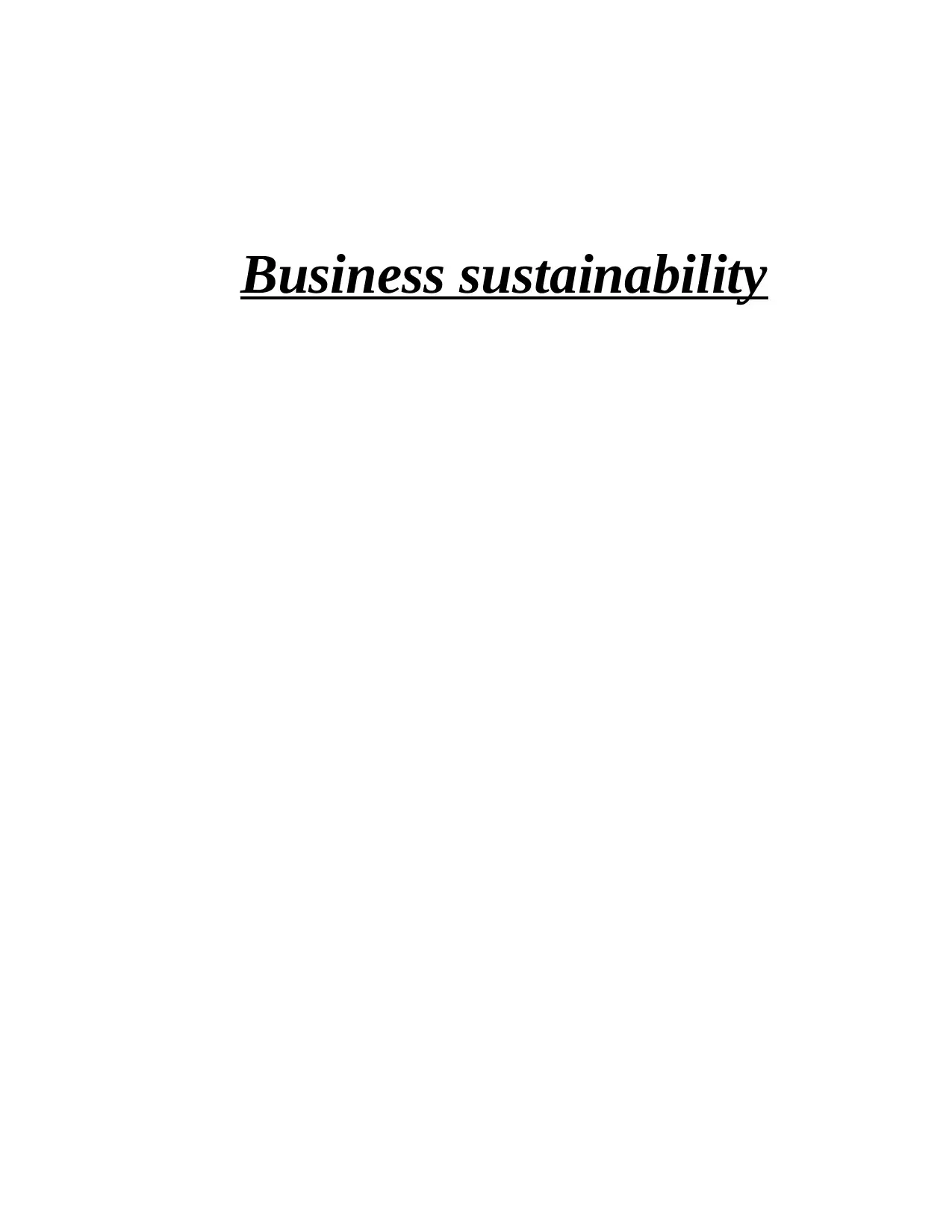
Business sustainability
Paraphrase This Document
Need a fresh take? Get an instant paraphrase of this document with our AI Paraphraser
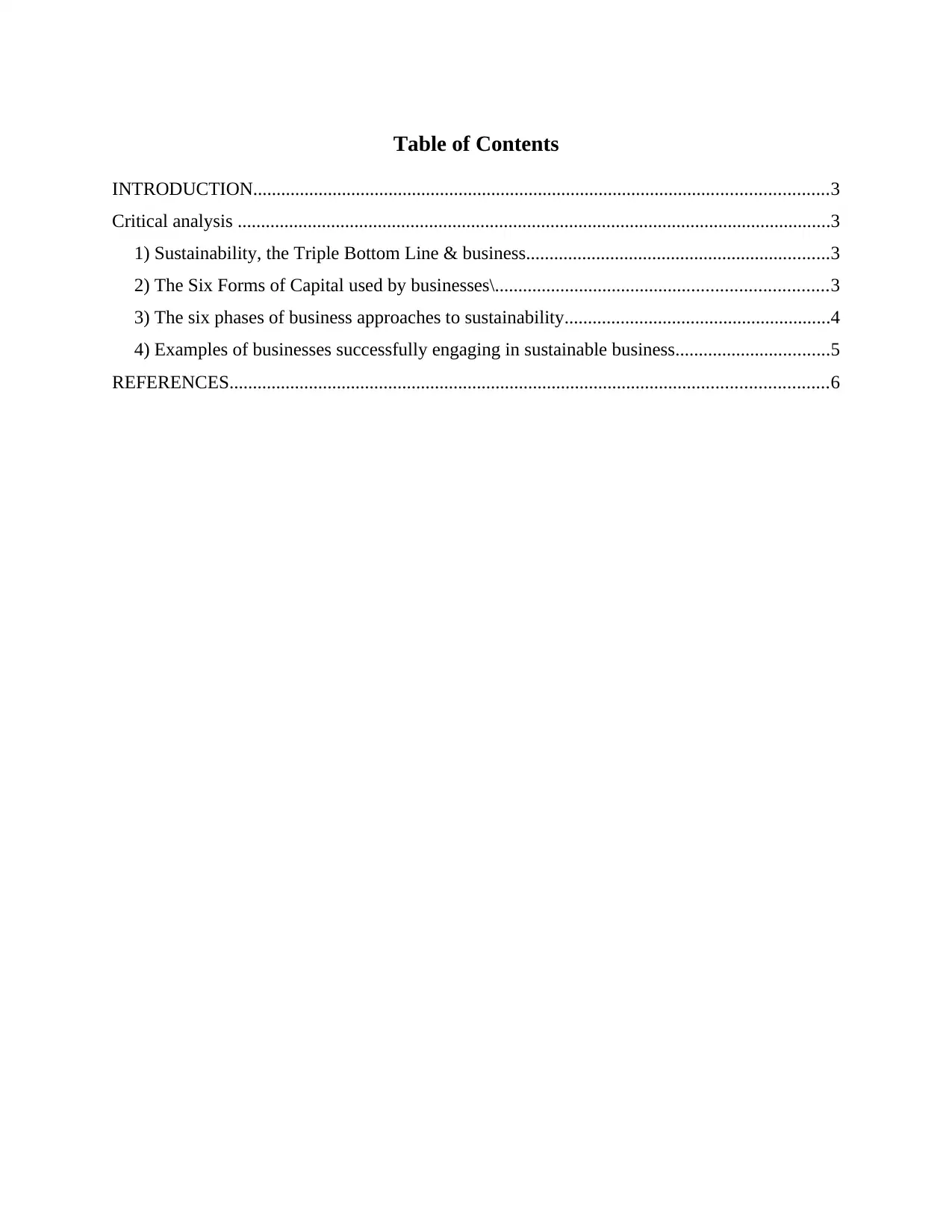
Table of Contents
INTRODUCTION...........................................................................................................................3
Critical analysis ...............................................................................................................................3
1) Sustainability, the Triple Bottom Line & business.................................................................3
2) The Six Forms of Capital used by businesses\.......................................................................3
3) The six phases of business approaches to sustainability.........................................................4
4) Examples of businesses successfully engaging in sustainable business.................................5
REFERENCES................................................................................................................................6
INTRODUCTION...........................................................................................................................3
Critical analysis ...............................................................................................................................3
1) Sustainability, the Triple Bottom Line & business.................................................................3
2) The Six Forms of Capital used by businesses\.......................................................................3
3) The six phases of business approaches to sustainability.........................................................4
4) Examples of businesses successfully engaging in sustainable business.................................5
REFERENCES................................................................................................................................6
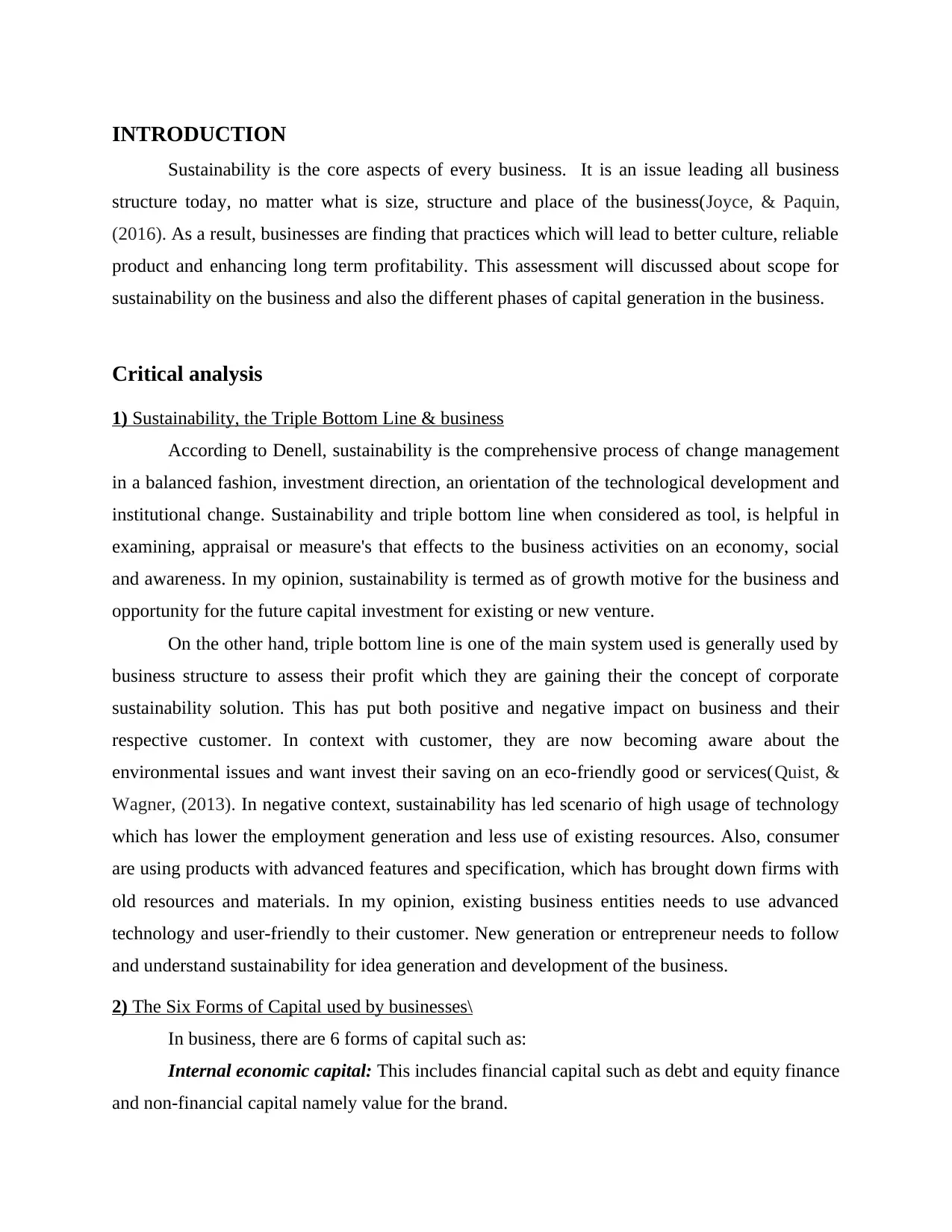
INTRODUCTION
Sustainability is the core aspects of every business. It is an issue leading all business
structure today, no matter what is size, structure and place of the business(Joyce, & Paquin,
(2016). As a result, businesses are finding that practices which will lead to better culture, reliable
product and enhancing long term profitability. This assessment will discussed about scope for
sustainability on the business and also the different phases of capital generation in the business.
Critical analysis
1) Sustainability, the Triple Bottom Line & business
According to Denell, sustainability is the comprehensive process of change management
in a balanced fashion, investment direction, an orientation of the technological development and
institutional change. Sustainability and triple bottom line when considered as tool, is helpful in
examining, appraisal or measure's that effects to the business activities on an economy, social
and awareness. In my opinion, sustainability is termed as of growth motive for the business and
opportunity for the future capital investment for existing or new venture.
On the other hand, triple bottom line is one of the main system used is generally used by
business structure to assess their profit which they are gaining their the concept of corporate
sustainability solution. This has put both positive and negative impact on business and their
respective customer. In context with customer, they are now becoming aware about the
environmental issues and want invest their saving on an eco-friendly good or services(Quist, &
Wagner, (2013). In negative context, sustainability has led scenario of high usage of technology
which has lower the employment generation and less use of existing resources. Also, consumer
are using products with advanced features and specification, which has brought down firms with
old resources and materials. In my opinion, existing business entities needs to use advanced
technology and user-friendly to their customer. New generation or entrepreneur needs to follow
and understand sustainability for idea generation and development of the business.
2) The Six Forms of Capital used by businesses\
In business, there are 6 forms of capital such as:
Internal economic capital: This includes financial capital such as debt and equity finance
and non-financial capital namely value for the brand.
Sustainability is the core aspects of every business. It is an issue leading all business
structure today, no matter what is size, structure and place of the business(Joyce, & Paquin,
(2016). As a result, businesses are finding that practices which will lead to better culture, reliable
product and enhancing long term profitability. This assessment will discussed about scope for
sustainability on the business and also the different phases of capital generation in the business.
Critical analysis
1) Sustainability, the Triple Bottom Line & business
According to Denell, sustainability is the comprehensive process of change management
in a balanced fashion, investment direction, an orientation of the technological development and
institutional change. Sustainability and triple bottom line when considered as tool, is helpful in
examining, appraisal or measure's that effects to the business activities on an economy, social
and awareness. In my opinion, sustainability is termed as of growth motive for the business and
opportunity for the future capital investment for existing or new venture.
On the other hand, triple bottom line is one of the main system used is generally used by
business structure to assess their profit which they are gaining their the concept of corporate
sustainability solution. This has put both positive and negative impact on business and their
respective customer. In context with customer, they are now becoming aware about the
environmental issues and want invest their saving on an eco-friendly good or services(Quist, &
Wagner, (2013). In negative context, sustainability has led scenario of high usage of technology
which has lower the employment generation and less use of existing resources. Also, consumer
are using products with advanced features and specification, which has brought down firms with
old resources and materials. In my opinion, existing business entities needs to use advanced
technology and user-friendly to their customer. New generation or entrepreneur needs to follow
and understand sustainability for idea generation and development of the business.
2) The Six Forms of Capital used by businesses\
In business, there are 6 forms of capital such as:
Internal economic capital: This includes financial capital such as debt and equity finance
and non-financial capital namely value for the brand.
⊘ This is a preview!⊘
Do you want full access?
Subscribe today to unlock all pages.

Trusted by 1+ million students worldwide
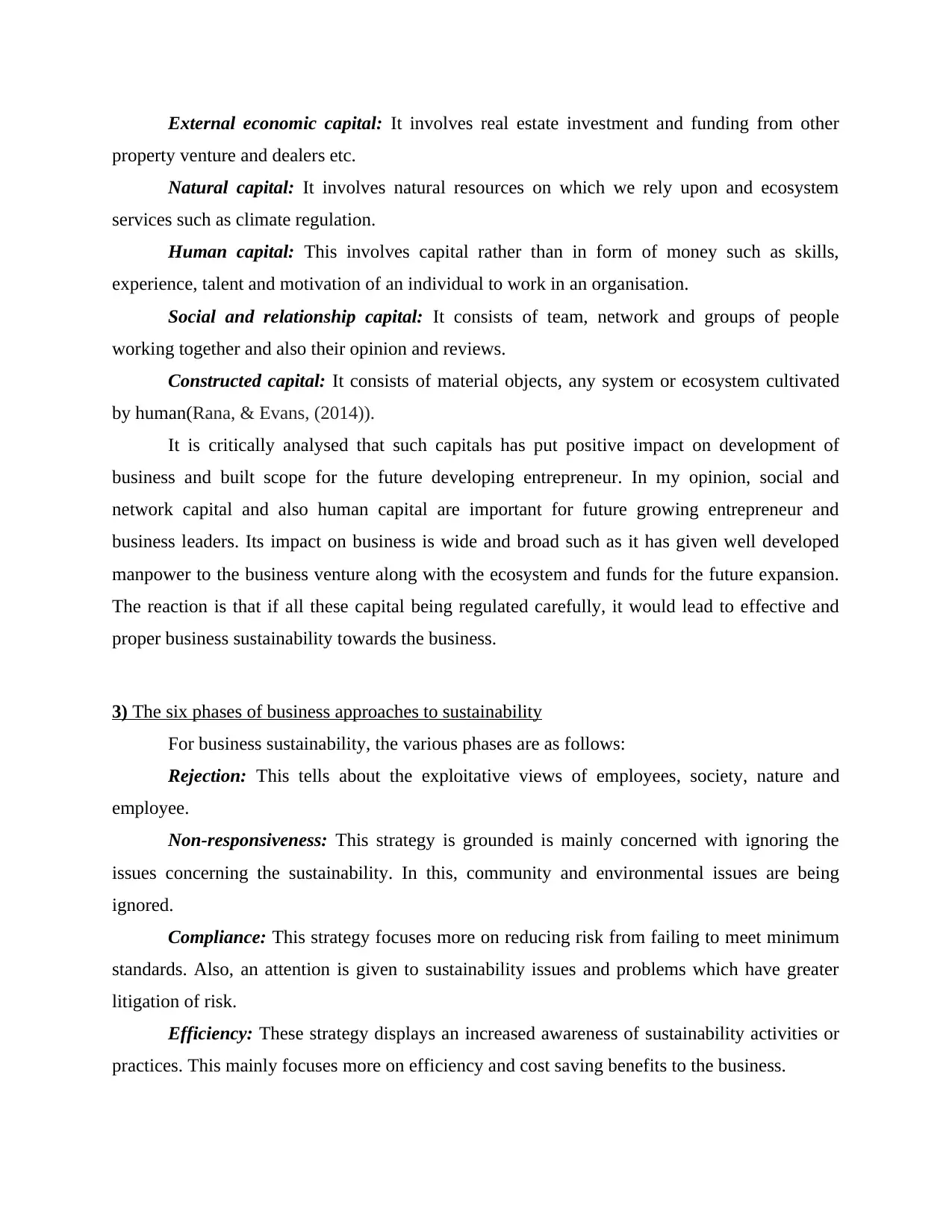
External economic capital: It involves real estate investment and funding from other
property venture and dealers etc.
Natural capital: It involves natural resources on which we rely upon and ecosystem
services such as climate regulation.
Human capital: This involves capital rather than in form of money such as skills,
experience, talent and motivation of an individual to work in an organisation.
Social and relationship capital: It consists of team, network and groups of people
working together and also their opinion and reviews.
Constructed capital: It consists of material objects, any system or ecosystem cultivated
by human(Rana, & Evans, (2014)).
It is critically analysed that such capitals has put positive impact on development of
business and built scope for the future developing entrepreneur. In my opinion, social and
network capital and also human capital are important for future growing entrepreneur and
business leaders. Its impact on business is wide and broad such as it has given well developed
manpower to the business venture along with the ecosystem and funds for the future expansion.
The reaction is that if all these capital being regulated carefully, it would lead to effective and
proper business sustainability towards the business.
3) The six phases of business approaches to sustainability
For business sustainability, the various phases are as follows:
Rejection: This tells about the exploitative views of employees, society, nature and
employee.
Non-responsiveness: This strategy is grounded is mainly concerned with ignoring the
issues concerning the sustainability. In this, community and environmental issues are being
ignored.
Compliance: This strategy focuses more on reducing risk from failing to meet minimum
standards. Also, an attention is given to sustainability issues and problems which have greater
litigation of risk.
Efficiency: These strategy displays an increased awareness of sustainability activities or
practices. This mainly focuses more on efficiency and cost saving benefits to the business.
property venture and dealers etc.
Natural capital: It involves natural resources on which we rely upon and ecosystem
services such as climate regulation.
Human capital: This involves capital rather than in form of money such as skills,
experience, talent and motivation of an individual to work in an organisation.
Social and relationship capital: It consists of team, network and groups of people
working together and also their opinion and reviews.
Constructed capital: It consists of material objects, any system or ecosystem cultivated
by human(Rana, & Evans, (2014)).
It is critically analysed that such capitals has put positive impact on development of
business and built scope for the future developing entrepreneur. In my opinion, social and
network capital and also human capital are important for future growing entrepreneur and
business leaders. Its impact on business is wide and broad such as it has given well developed
manpower to the business venture along with the ecosystem and funds for the future expansion.
The reaction is that if all these capital being regulated carefully, it would lead to effective and
proper business sustainability towards the business.
3) The six phases of business approaches to sustainability
For business sustainability, the various phases are as follows:
Rejection: This tells about the exploitative views of employees, society, nature and
employee.
Non-responsiveness: This strategy is grounded is mainly concerned with ignoring the
issues concerning the sustainability. In this, community and environmental issues are being
ignored.
Compliance: This strategy focuses more on reducing risk from failing to meet minimum
standards. Also, an attention is given to sustainability issues and problems which have greater
litigation of risk.
Efficiency: These strategy displays an increased awareness of sustainability activities or
practices. This mainly focuses more on efficiency and cost saving benefits to the business.
Paraphrase This Document
Need a fresh take? Get an instant paraphrase of this document with our AI Paraphraser
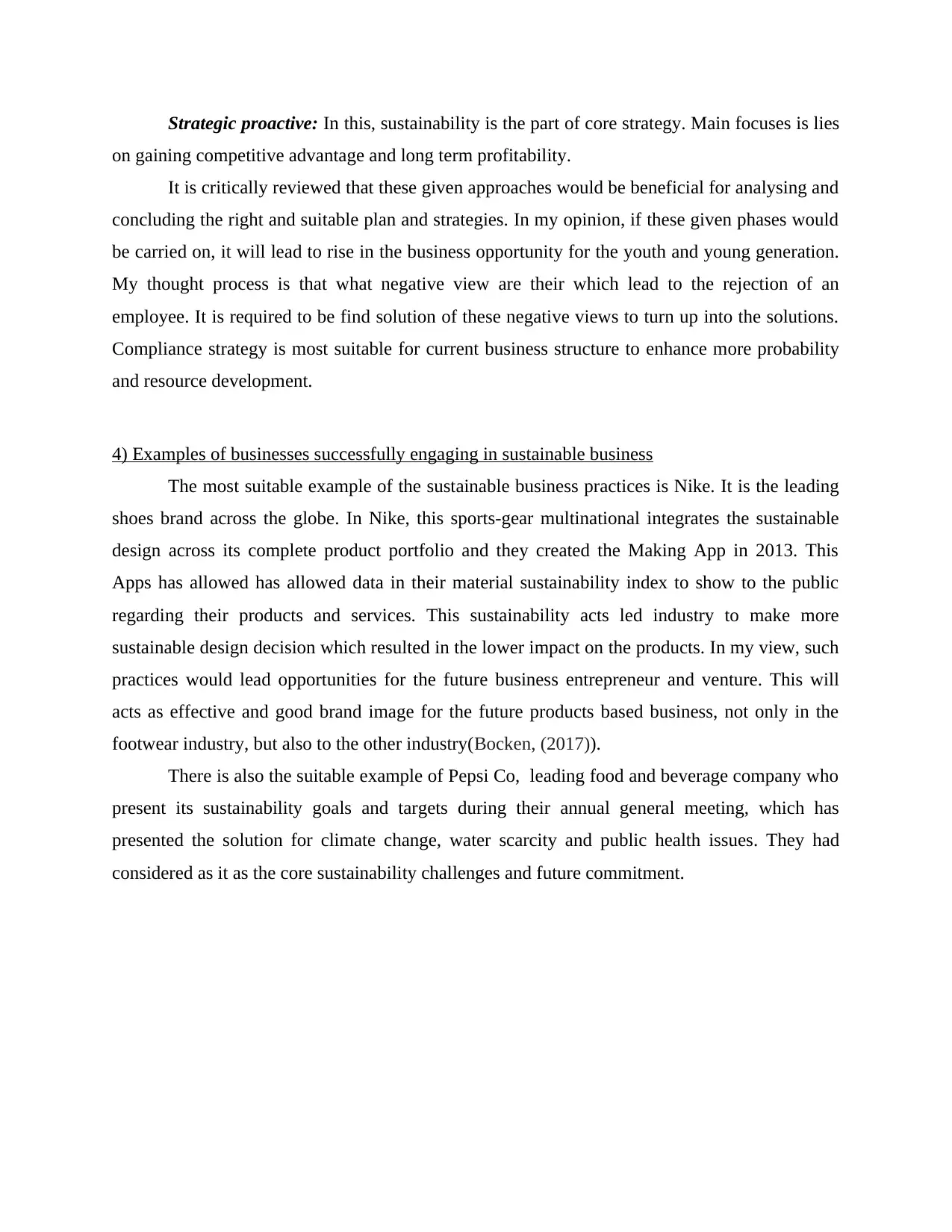
Strategic proactive: In this, sustainability is the part of core strategy. Main focuses is lies
on gaining competitive advantage and long term profitability.
It is critically reviewed that these given approaches would be beneficial for analysing and
concluding the right and suitable plan and strategies. In my opinion, if these given phases would
be carried on, it will lead to rise in the business opportunity for the youth and young generation.
My thought process is that what negative view are their which lead to the rejection of an
employee. It is required to be find solution of these negative views to turn up into the solutions.
Compliance strategy is most suitable for current business structure to enhance more probability
and resource development.
4) Examples of businesses successfully engaging in sustainable business
The most suitable example of the sustainable business practices is Nike. It is the leading
shoes brand across the globe. In Nike, this sports-gear multinational integrates the sustainable
design across its complete product portfolio and they created the Making App in 2013. This
Apps has allowed has allowed data in their material sustainability index to show to the public
regarding their products and services. This sustainability acts led industry to make more
sustainable design decision which resulted in the lower impact on the products. In my view, such
practices would lead opportunities for the future business entrepreneur and venture. This will
acts as effective and good brand image for the future products based business, not only in the
footwear industry, but also to the other industry(Bocken, (2017)).
There is also the suitable example of Pepsi Co, leading food and beverage company who
present its sustainability goals and targets during their annual general meeting, which has
presented the solution for climate change, water scarcity and public health issues. They had
considered as it as the core sustainability challenges and future commitment.
on gaining competitive advantage and long term profitability.
It is critically reviewed that these given approaches would be beneficial for analysing and
concluding the right and suitable plan and strategies. In my opinion, if these given phases would
be carried on, it will lead to rise in the business opportunity for the youth and young generation.
My thought process is that what negative view are their which lead to the rejection of an
employee. It is required to be find solution of these negative views to turn up into the solutions.
Compliance strategy is most suitable for current business structure to enhance more probability
and resource development.
4) Examples of businesses successfully engaging in sustainable business
The most suitable example of the sustainable business practices is Nike. It is the leading
shoes brand across the globe. In Nike, this sports-gear multinational integrates the sustainable
design across its complete product portfolio and they created the Making App in 2013. This
Apps has allowed has allowed data in their material sustainability index to show to the public
regarding their products and services. This sustainability acts led industry to make more
sustainable design decision which resulted in the lower impact on the products. In my view, such
practices would lead opportunities for the future business entrepreneur and venture. This will
acts as effective and good brand image for the future products based business, not only in the
footwear industry, but also to the other industry(Bocken, (2017)).
There is also the suitable example of Pepsi Co, leading food and beverage company who
present its sustainability goals and targets during their annual general meeting, which has
presented the solution for climate change, water scarcity and public health issues. They had
considered as it as the core sustainability challenges and future commitment.
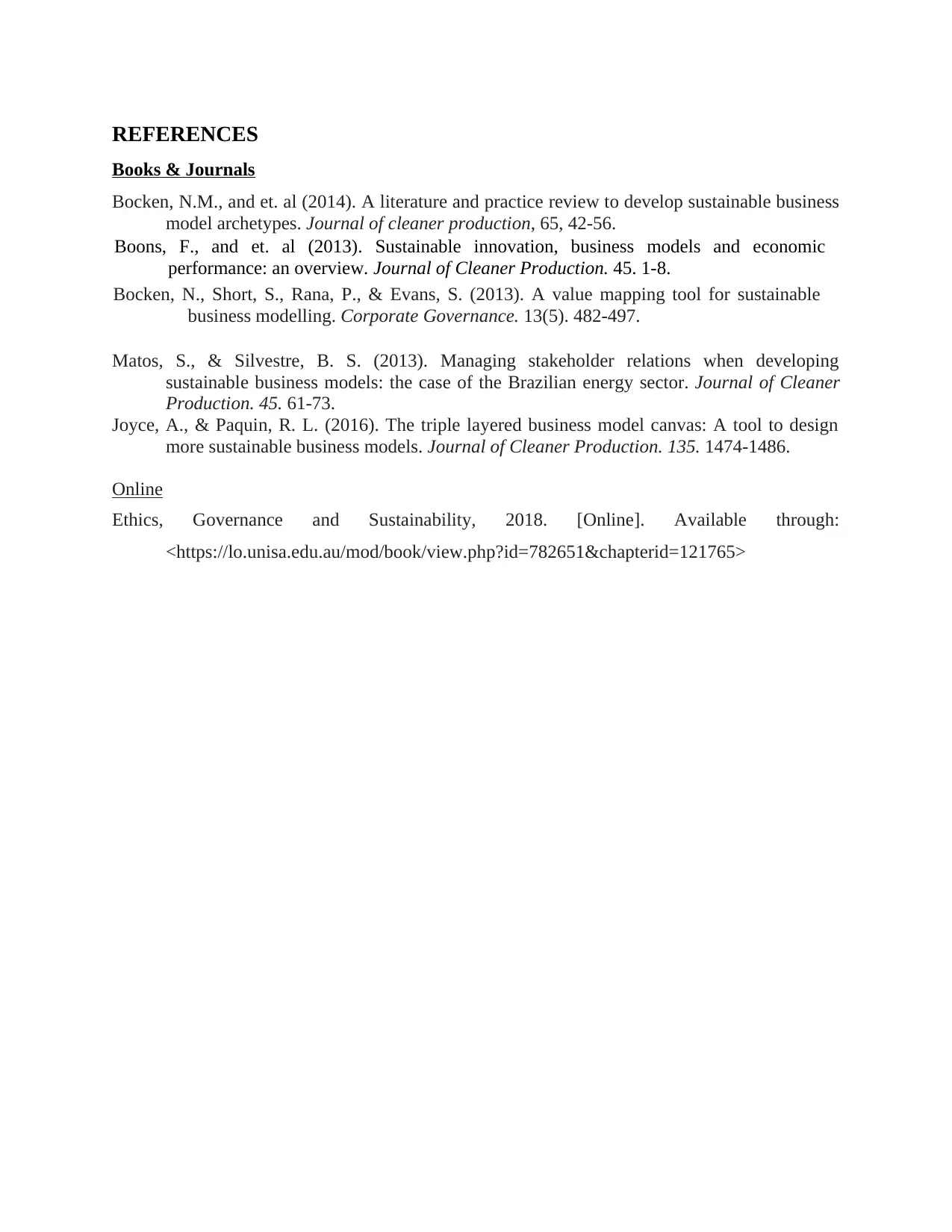
REFERENCES
Books & Journals
Bocken, N.M., and et. al (2014). A literature and practice review to develop sustainable business
model archetypes. Journal of cleaner production, 65, 42-56.
Boons, F., and et. al (2013). Sustainable innovation, business models and economic
performance: an overview. Journal of Cleaner Production. 45. 1-8.
Bocken, N., Short, S., Rana, P., & Evans, S. (2013). A value mapping tool for sustainable
business modelling. Corporate Governance. 13(5). 482-497.
Matos, S., & Silvestre, B. S. (2013). Managing stakeholder relations when developing
sustainable business models: the case of the Brazilian energy sector. Journal of Cleaner
Production. 45. 61-73.
Joyce, A., & Paquin, R. L. (2016). The triple layered business model canvas: A tool to design
more sustainable business models. Journal of Cleaner Production. 135. 1474-1486.
Online
Ethics, Governance and Sustainability, 2018. [Online]. Available through:
<https://lo.unisa.edu.au/mod/book/view.php?id=782651&chapterid=121765>
Books & Journals
Bocken, N.M., and et. al (2014). A literature and practice review to develop sustainable business
model archetypes. Journal of cleaner production, 65, 42-56.
Boons, F., and et. al (2013). Sustainable innovation, business models and economic
performance: an overview. Journal of Cleaner Production. 45. 1-8.
Bocken, N., Short, S., Rana, P., & Evans, S. (2013). A value mapping tool for sustainable
business modelling. Corporate Governance. 13(5). 482-497.
Matos, S., & Silvestre, B. S. (2013). Managing stakeholder relations when developing
sustainable business models: the case of the Brazilian energy sector. Journal of Cleaner
Production. 45. 61-73.
Joyce, A., & Paquin, R. L. (2016). The triple layered business model canvas: A tool to design
more sustainable business models. Journal of Cleaner Production. 135. 1474-1486.
Online
Ethics, Governance and Sustainability, 2018. [Online]. Available through:
<https://lo.unisa.edu.au/mod/book/view.php?id=782651&chapterid=121765>
⊘ This is a preview!⊘
Do you want full access?
Subscribe today to unlock all pages.

Trusted by 1+ million students worldwide
1 out of 6
Related Documents
Your All-in-One AI-Powered Toolkit for Academic Success.
+13062052269
info@desklib.com
Available 24*7 on WhatsApp / Email
![[object Object]](/_next/static/media/star-bottom.7253800d.svg)
Unlock your academic potential
Copyright © 2020–2025 A2Z Services. All Rights Reserved. Developed and managed by ZUCOL.



